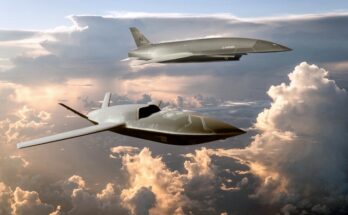Following a phone conversation between Turkish President Recep Tayyip Erdogan and U.S. President Donald Trump on October 6, Turkey launched a major combat operation – dubbed “Peace Spring” – into northeast Syria three days later on October 9.
The offensive itself has garnered much international debate and a surfeit of heavy criticism within U.S. national security circles toward President Trump’s seeming acquiescence to Turkish demands and his abandonment of the U.S.’s hard-fighting allies in the region, the Kurdish People’s Protection Units, more commonly referred to as the YPG.
Yet rather scant attention has been paid in the same U.S. national security community toward Turkey’s outlook.
The Turkish aim as spelled out by Erdogan is to create a buffer zone along Turkey’s southeast border with Syria that would stretch some 450 kilometers (280 miles) and penetrate 30 kilometers (19 miles) into de jure Syrian territory. Here a new home will be built for some of the roughly 3.6 million Syrian refugees that have fled into Turkey since the Syrian civil war broke out in 2011.
The step undertaken by Turkey has for sure garnered much international criticism, including from the same U.S. president who, in effect, gave Erdogan the green-light by ordering the small contingent of U.S. forces stationed along the Syrian-Turkish border to pull back.
From the U.S. vantage point, the Turkish military operation looks like steps undertaken by an increasingly authoritarian leader who seeks to turn his back on the West and align closer to like-minded governments such as Russia.
To Western policymakers – particularly those within the D.C. Beltway – Erdogan increasingly resembles a Latin American tin-pot dictator, one who is moving away from Turkey’s NATO Alliance orientation toward one of mutual understanding with the authoritarian regimes of Russia and Syria.
While certainly not ill-considered, this outlook also overlooks deep-rooted Turkish concerns and political machinations inside Turkey.
The Turkish president – who has steadily worked to consolidate power since first ascending to the prime minister post in March 2003 – is willing to bear the brunt of external opprobrium so long as it serves his internal political calculations.
What forms those calculations?
For starters, there is the Kurdish issue.
Turkey is home to a sizable Kurdish minority constituting nearly 20 percent of the country’s total population. This minority is also without an ethnic home of its own, meaning despite having large populations spilling across borders into Turkey, Syria, Iran and Iraq, the Kurds remain a minority group wherever they reside.
Within its own borders, Turkey has had to contend with a militant Kurdish separatist element, the Kurdish-nationalist Kurdistan Workers’ Party, or PKK. The PKK – an outlawed party labeled a terrorist organization by Turkey, the European Union, Japan, and the United States – represents a national security issue for Turkish authorities, regardless of the political party ruling in Ankara.
In 1984 the PKK launched an insurgency in southeastern Turkey, often using terrorist tactics to try to attain its goal of an independent Kurdistan carved from its native regions in southeastern Turkey, northern Syria, and northern Iraq. The insurgency lasted 15 years and cost more than 20,000 lives, finally ending in 2000 after the capture of PKK guerrilla leader Abdullah Ocalan.
Because of this, many in Turkey continue to view the Kurdish population as a potential fifth column within national borders. The current offensive has galvanized public opinion behind Erdogan while allowing Turkish authorities to crack down on the pro-Kurdish People’s Democracy Party, the only major political opposition to the military operation and the third-largest party in Turkey’s Parliament.
Hence the current situation is used as an opportunity by the Erdogan government to shut down dissent.
Turkey replaces the mayors of a Kurdish-majority town in its southeast with a state official, the pro-Kurdish Peoples’ Democratic Party (HDP) says, amid a crackdown at home on criticism of Ankara’s offensive in Syria.https://t.co/OcJ1Mt9fPk
— Al Arabiya English (@AlArabiya_Eng) October 18, 2019
Then there is the ongoing civil conflict in Syria. Since the onset of the fighting in Syria, the Erdogan playbook shifted opportunely from one of increasing closeness to the Assad regime to one of arming insurgents against forces loyal to the Syrian president. At the same time, burnishing his Muslim bona fides, Erdogan opened Turkey’s borders to the flood of refugees fleeing from the chaos and carnage of Syria.
Ultimately Turkey would absorb some 3.6 million Syrian refugees.
This was all well and good until the Turkish economy began to slow measurably in the face of higher inflation, a rising trade imbalance and external debt, and the depreciation of the Turkish lira against the U.S. dollar. Suddenly the welcome mat put out by Erdogan – an act of Sunni Muslim charity and solidarity meant for external consumption as much as one of genuine concern – no longer played as well for him domestically.
Erdogan’s steady accumulation of power faced other challenges, too, one in particular more directly existential than a slowdown in economic growth.
First, his Justice and Development Party saw its parliamentary majority diminish in 2015, forcing Erdogan to align with the far-right Nationalist Movement Party (MHP), which strongly opposes any hint of Kurdish nationalism.
Second, and more important, was the attempted military coup d’etat undertaken on the evening of July 15, 2016. Despite the understandable fear it struck in Erdogan, the failed coup ultimately served to aid him in solidifying power and hasten the demise of the nearly 100-year Kemalist era – the secular republic shaped by Mustafa Kemal, better known as Ataturk, or “Father of the Turks” – which emerged from the ashes of the former Ottoman Empire in 1923.
Once the dust settled following the failed coup, the Erdogan government moved quickly to eliminate potential “enemies from within” by having 9,000 police officers fired, 3,000 judges suspended, and 6,000 military personnel arrested (including 103 generals and admirals), plus the forced suspension of 15,200 education staff members and a government demand for all public university deans to resign.
From the Islamist-minded outlook of the Justice and Development Party (AKP) government, the Turkish military – once the guardian of the Kemalist establishment and its secularist constitutional ideals – had been necessarily de-fanged.
However, maintaining that loyalty depends on being perceived as acting in Turkey’s national interests rather than those of the AKP or Erdogan personally.
For Erdogan, the issue of Kurdish incursions across borders or the idea of a nascent Kurdish-administered enclave nestled astride Turkey’s border, however real or imagined, offer an opportunity to direct attention away from the country’s fragile economy. A military operation against the YPG is therefore something many Turks, regardless of political loyalties, are unified by.
Erdogan says no world power can stop Turkey’s military offensive in Syria https://t.co/di7Q4gvkU6 pic.twitter.com/CAQrcmL7cV
— Al Jazeera English (@AJEnglish) October 17, 2019
The conflict in Syria allows Turkey to argue that its own security needs have been overlooked by its NATO allies – including the U.S. – in their rush to combat Islamic State (IS) elements and use the YPG as their proxy security force. The issue has been simmering as Turkey has looked on in dissatisfaction with U.S. efforts to jointly administer with Turkey a security buffer area between the Kurdish-led Syrian Democratic Forces (SDF) and Turkey’s border that was ironed out in August.
Once U.S. forces were withdrawn and Turkish forces moved into Syria, the seeds of Erdogan’s gamble were sown.
The first aim is to cripple the YPG-led SDF, which in Turkish eyes presents an existential threat. Doing so would push Kurdish forces away from Turkey’s border and remove a cross-border sanctuary for PKK elements (PKK leadership hid in Syria and set up training camps there in the 1980s through the 1990s until Ankara threatened former Syrian President Hafez Assad with military reprisals in 1998).
The second goal is to “repatriate” refugees into the Turkish-created “peace zone,” thus easing some of the domestic pressure at home and creating a Sunni-dominated buffer area. If that area has fewer Kurds and zero YPG elements, then all the more better for Erdogan – and Turkey. The Turkish president ends up receiving plaudits at home and (ideally) Turkish security concerns dwindle along the 280-mile stretch of its southeast border.
From that myopic perspective, it’s a win-win.
Still, a peace zone dominated by returning refugees presents its own massive problems-in-the-making for Turkey, not just the international condemnation and diplomatic isolation sure to come down on Ankara, but the logistical and humanitarian issues that will arise. Nonetheless, Erdogan – who touted the peace zone solution to the United Nations General Assembly prior to the launch of the offensive – is determined to try.
His road map includes scores of new homes built for the displaced refugees, plus hospitals, mosques, sports facilities and schools. Where the money to fund this new settlement will be found of course begs the question, but from the perspective of the Turkish president, the abundance of make-work projects would ostensibly provide a steady drumbeat of jobs for Turkish construction companies and a brief stimulus that may (although unlikely) allow Turkey to ride out the short-term effects of any economic sanctions imposed upon it by other countries.
Finally, by carving out a space in Syrian territory, Turkey gains a degree of leverage in any discussion regarding the future of Syria.
The risks involved in all this for Erdogan and his AKP government in terms of blood, treasure, political capital, and diplomatic isolation are clear. This is a gamble – but a calculated one. Erdogan is buying a foreign policy/security headache and a weakened position both for his own political future and for Turkey if things go awry. Winning the battle for international opinion was a losing proposition for him once Turkish troops moved south, but winning a reprieve in the public square at home is the real war.
But he’s sized up the U.S. president and found him agreeable to his own needs, while his government long ago gave up on the idea of Turkish accession into the European Union. In short, fallout with the Western community has become an inevitability and worth the risk.
As for Russia, always a security concern for Turkey, Erdogan sees a like-minded leader in Vladimir Putin and recognizes that it will be Moscow – and not Washington – that will always have the stronger hand to play in determining Syria’s destiny.
For Erdogan, ensuring a “Greater Kurdistan” does not emerge in northern Syria while relieving the pressure valve of internal unrest is a worthwhile risk. Now the rest of the world watches to see how this plays out.

Dan Darling is Forecast International’s director of military and defense markets. In this role, Dan oversees a team of analysts tasked with covering everything from budgeting to weapons systems to defense electronics and military aerospace. Additionally, for over 17 years Dan has, at various times, authored the International Military Markets reports for Europe, Eurasia, the Middle East and the Asia-Pacific region.
Dan's work has been cited in Defense News, Real Clear Defense, Asian Military Review, Al Jazeera, and Financial Express, among others, and he has also contributed commentary to The Diplomat, The National Interest and World Politics Review. He has been quoted in Arabian Business, the Financial Times, Flight International, The New York Times, Bloomberg and National Defense Magazine.
In addition, Dan has made guest appearances on the online radio show Midrats and on The Media Line, as well as The Red Line Podcast, plus media appearances on France 24 and World Is One News (WION).




